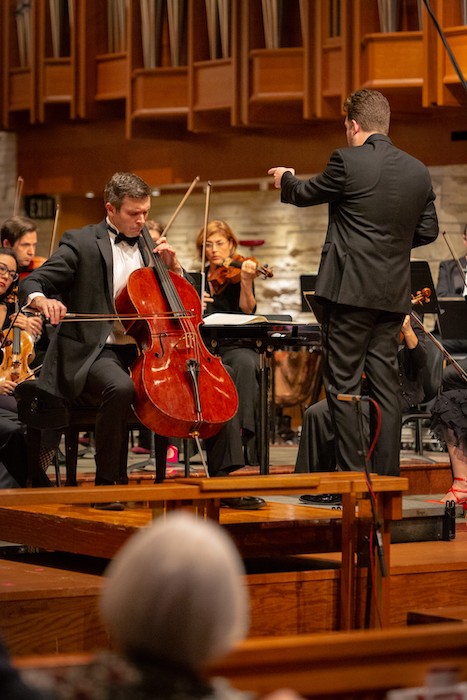Mitchell, River Oaks CO rove widely, from Mozart to Kilar

Brett Mitchell conducted the River Oaks Chamber Orchestra Saturday night in Houston. Photo: ROCO / Blueprint Film Co.
Houston’s Church of St. John the Divine, with its compact and somewhat reverberant sanctuary, helps the River Oaks Chamber Orchestra pull off a neat trick.
When the 40-player ensemble performs here, it not only boasts the group’s usual nimbleness and clarity, but the acoustic enhances their sound with a fullness usually associated with larger groups.
That came in handy on Saturday night. The program ranged from Wojciech Kilar’s Orawa, a string-ensemble piece, to Ethel Smyth’s Overture to The Wreckers, which is typically full-orchestra fare. Mozart’s Symphony No. 35 and others works came in between.
Led by conductor Brett Mitchell, music director of the Colorado Symphony, the orchestra moved adroitly among styles and sounds, capturing The Wreckers’ heft as readily as the Haffner’s airiness and zip.
For The Wreckers, Houston composer Mark Buller supplied a condensed arrangement that shaved off a few wind parts but preserved Smyth’s sonorous tonal palette, with its echoes of Brahms and Elgar. Right from the dynamic opening theme, the orchestra brought the overture heft and boldness.
Besides spurring the orchestra to play so vigorously, Mitchell guided it confidently through the overture’s mood changes. When a waltz suddenly interrupted the agitation, Mitchell and the orchestra gave it a lustiness that may have harkened back to the opera’s setting in a British village; when the music took a clangorous, aggressive turn, the orchestra dug into it fiercely.
Kilar, a Polish composer who spent much of his career writing film music—including the score to Roman Polanski’s The Pianist—wrote Orawa in homage to the river of that name in eastern Europe. Speaking Saturday from the podium, Mitchell said the piece gripped him when he discovered it as a graduate student 20 or so years ago.
Orawa’s main motif boasts the crispness and buoyancy of folk music. But if the style outwardly resembles Dvořák Slavonic Dance, Kilar draws on minimalist repetition as he builds that short theme and a few sidelights into a dynamic, propulsive six-minute piece.
The orchestra played with incisiveness and momentum as Mitchell steered it through Kilar’s meter changes and sudden changes of tone, including a pounding theme that breaks out at one point. The players unleashed bursts of virtuosity in the whirlwind filigree that propelled the music to its climax.
The orchestra had dubbed the program “Ticket to Ride,” casting it as a musical tour of nations. The linchpin was a new work inspired by trains: Jim Stephenson’s ROCOmotive, whose title plays off the River Oaks Chamber Orchestra’s initials.
Stephenson, a trumpeter-turned composer who lives near Chicago, explained from the stage that the work pays homage to the model trains of his youth. Creating it gave him a chance to “revisit my childhood.”
The work sidesteps the rhythmic explosiveness of, say, Arthur Honegger’s Pacific 231. Cast in five short movements, ROCOmotive is lighter and brighter. While there are certainly some reflections of speed–as in the zooming, sparkling first movement, the music also takes a relaxed turn; the spacious finale has a decidedly nostalgic air, with the strings singing out in long, broad lines.
Mitchell and the orchestra revealed the music’s color and charm. The musicians raced through the first and fourth movements with breeziness and clarity. But they also brought a cozy intimacy to the second movement and a jaunty cheerfulness to the third, which included nimble solos for oboe and flute.

Richard Belcher performed Saint-Saëns’ Cello Concerto No. 1 Saturday night. Photo: ROCO / Blueprint Film Co
The orchestra’s principal cellist, Richard Belcher, took center stage in Camille Saint-Saëns’ Concerto No. 1. He played with a full-blooded soloist’s flair and projection, filling the first movement with swagger and richness. Yet Belcher took a lighter tone as the cello floated above the orchestra’s second-movement minuet. And in the finale, he ranged from dashing energy to whispering lyricism. The orchestra complemented Belcher all the way, especially when Mitchell guided it down to an even quieter pianissimo than the solo cello in parts of the finale.
Mitchell also directed the orchestra to relish Mozart’s energy and exuberance in the Haffner without allowing the church’s reverberation to muddy the textures. The strings’ nimbleness and precision played a key role, and Mitchell had the winds ringing out brightly without overdoing it.